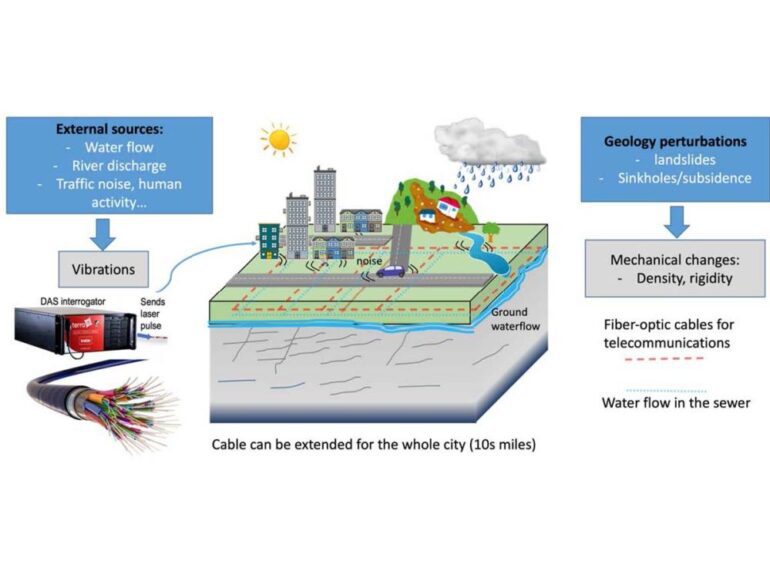TL;DR:
- A $937,000 NSF grant has been awarded to a joint effort by Penn State and Carnegie Mellon University (CMU) researchers in Pittsburgh.
- The project aims to utilize existing fiber optic cables and machine learning to track ground hazards in a cost-effective manner.
- Distributed Acoustic Sensing (DAS), developed by Tieyuan Zhu, will capture nanoscale vibrations through data cables to diagnose hazards.
- DAS offers significant cost savings, around one-tenth of traditional hazard sensors, and can assess hazards over large urban areas.
- The research is part of the Civic Innovation Challenge, focused on using emerging technologies to address community challenges.
- Pittsburgh was chosen due to its aging infrastructure, challenging terrain, and susceptibility to geological hazards.
- The project emphasizes community engagement and inclusivity in its approach.
- DAS enables real-time, precise hazard identification and localization, allowing for targeted and timely interventions.
- The pilot project will test the DAS approach in a specific area of Pittsburgh and could serve as a proof of concept for wider implementation.
- The economic assessment of the technology is led by Zhen Lei, an associate professor of energy and environmental economics at Penn State.
Main AI News:
In an era marked by the convergence of cutting-edge technology and urban challenges, a transformative project is underway in Pittsburgh. Supported by a substantial $937,000 grant from the National Science Foundation (NSF), a collaborative team of experts from Penn State and Carnegie Mellon University (CMU) is pioneering a groundbreaking approach to monitor ground hazards in the city. Led by Tieyuan Zhu, an esteemed associate professor of geosciences at Penn State, this initiative combines existing fiber optic cables with the power of machine learning, offering a cost-effective and efficient solution for tracking potential dangers.
This innovative endeavor builds upon previous research findings that reveal how hazards such as flooding, landslides, sinkholes, and pipeline leaks can be effectively monitored at a fraction of the cost compared to conventional methods. The crux of this pioneering approach lies in distributed acoustic sensing (DAS), a technology developed by Zhu. DAS utilizes nanoscale vibrations collected through data cables to detect and diagnose hazards spanning extensive areas, presenting a cost-saving alternative to traditional hazard sensors employed in Pittsburgh.
Tieyuan Zhu, the driving force behind this ambitious project, highlights the pressing need for real-time information regarding subsurface conditions in cities worldwide. He emphasizes the interconnected challenges posed by geohazards, aging infrastructure, and climate change, which manifest as issues like deteriorating sewer systems, storm-induced flooding, and geotechnical failures such as sinkholes and landslides. Despite their critical role in urban environments, there is often a scarcity of up-to-date data on subsurface conditions. Zhu’s project aims to bridge this information gap and revolutionize hazard management.
The NSF grant, a prestigious accolade among only 19 awarded nationwide, is part of the Civic Innovation Challenge—an initiative dedicated to leveraging emerging technologies to address pressing community issues. Zhu’s team selected Pittsburgh as the ideal testbed due to its aging infrastructure, challenging topography, and susceptibility to geological hazards. Collaborators such as David Himes, sustainable communities manager at the Penn State Center Pittsburgh, and Karen Lightman, executive director of CMU’s Metro21: Smart Cities Institute, are instrumental in forging partnerships with local municipalities and utilities, ensuring an inclusive and equitable approach to the project.
Central to the innovation is DAS, which is capable of delivering city-wide signals along fiber optic cables almost in real time. This capability empowers researchers to pinpoint and localize environmental and infrastructure hazards, offering cities, utilities, and communities the opportunity for precise and timely interventions. This approach promises to be both cost-effective and tailored to the unique challenges faced by affected communities.
As the pilot project unfolds, it will focus on a specific area of Pittsburgh to test the effectiveness of the DAS approach. Calibration will be carried out alongside conventional sensors, with input from civic partners. The challenges posed by Pittsburgh’s diverse landscape are anticipated to serve as proof of concept, demonstrating the potential for wider implementation in other regions.
Lauren McPhillips, assistant professor of civil and environmental engineering at Penn State, will validate the DAS against existing sensors, ensuring its accuracy and reliability. Meanwhile, Zhen Lei, associate professor of energy and environmental economics at Penn State, will lead the economic assessment of this groundbreaking technology.
Tieyuan Zhu envisions extensive community engagement throughout the project, showcasing the transformative potential of this new real-time sensing system. He believes that this initiative will not only reshape how cities manage geo-environmental and infrastructure challenges but also pave the way for smarter, sustainable, and more equitable urban environments. While Pittsburgh serves as an initial proving ground, Zhu anticipates that the insights gained will facilitate the broader adoption of this impactful tool in cities worldwide.
Conclusion:
The integration of fiber optic cables and machine learning for urban hazard monitoring represents a significant innovation. This technology has the potential to disrupt the market for hazard monitoring solutions, offering cost-effective, real-time insights that can be tailored to specific communities. As cities worldwide grapple with geohazards, aging infrastructure, and climate change, this approach may become a sought-after solution for creating resilient and sustainable urban environments. Investors and companies in the hazard monitoring sector should closely monitor the development and adoption of this technology for potential market opportunities and competitive advantages.

